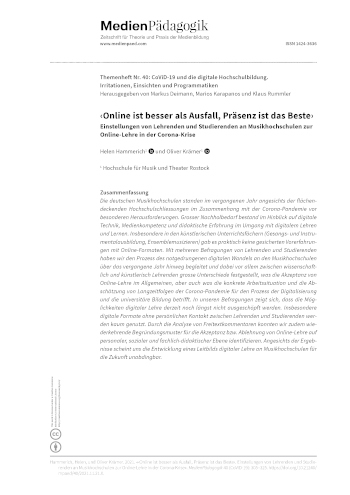Abstract
Last year, due to the nationwide university closings in connection with the corona pandemic, German universities of music faced particular challenges in terms of catching up with the digital technology, media skills and didactic experience in dealing with digital teaching and learning. In particular in the artistic subjects (vocal and instrumental tuition, ensemble courses) there was nearly any reliable experience with online formats. With several surveys of music teachers and students, we have accompanied the externally forced digital change over the past year. Our findings show major differences especially between academic and artistic teachers in terms of the acceptance of online teaching in general, but also concerning the specific work situation and the assessment of the long-term consequences of the corona pandemic for the process of digitization and university education. Our surveys show that the possibilities of digital teaching aren’t used to its full range. Especially formats without personal contact are hardly taken into account when thinking about teaching strategies. Through the analysis of free text comments, we were also able to identify recurring justification patterns for the acceptance or the rejection of online teaching on a personal, socio-ecological and content-related didactic level. In view of the results, the development of a mission statement for digital teaching at the universities of music seems to be indispensable for the future.
References
Anders, Florentine. 2020. Lehrer-Umfrage. Erstmals repräsentative Daten zum Fernunterricht. https://deutsches-schulportal.de/unterricht/das-deutsche-schulbarometer-spezial-corona-krise/.
Ahner, Philipp. 2019. «E-Learning in Musikschulen. Zwischen Freiräumen, persönlichem Kontakt, anonymen Online-Kursen und inhaltlicher Vorbestimmtheit.» üben & musizieren 1/2019: 6–9. https://uebenundmusizieren.de/artikel/e-learning-in-musikschulen/.
Deutsches Schulportal. 2020. Das deutsche Schulbarometer spezial. Lehrerbefragung zur Corona-Krise. https://deutsches-schulportal.de/unterricht/das-deutsche-schulbarometer-spezial-corona-krise/.
Deverich, Robin K. 1998. Distance education strategies for strings: A framework of violin instruction for adult amateurs. Dissertation, University of Southern California. https://www.proquest.com/docview/304455917.
EFI – Expertenkommission Forschung und Innovation. 2019. Gutachten zu Forschung, Innovation und technologischer Leistungsfähigkeit Deutschlands 2019. https://www.e-fi.de/fileadmin/Gutachten_2019/EFI_Gutachten_2019.pdf.
Füller, Christian, und Martin Spiewak. 2020. «Hausaufgabe». DIE ZEIT (17): 27 16.04.2020.
Gilch, Harald, Anna S. Beise, René Krempkow, Marko Müller, Friedrich Stratmann, und Klaus Wannemacher. 2019. Digitalisierung der Hochschulen. Ergebnisse einer Schwerpunktstudie für die Expertenkommission Forschung und Innovation. Studien zum deutschen Innovationssystem. http://hdl.handle.net/10419/194284.
Godau, Marc. 2020. «Zoom im Musikunterricht? Wie Konferenz-Plattformen Musiklernen auf Distanz ermöglichen können». Musik & Unterricht 148: 40–41.
Godau, Marc, und Matthias Krebs. 2017. «Weiterbildung als Community of Practice? Zur forschungsbasierten Entwicklung der Weiterbildung ‹Zertifikatskurs tAPP – Musik mit Apps in der Kulturellen Bildung›». In Musikpädagogik und Kulturwissenschaft. Music Education and Cultural Studies, herausgegeben von Alexander J. Cvetko und Christian Rolle, 73–86. Münster: Waxmann. https://doi.org/10.25656/01:15626.
Godau, Marc, und Verena Weidner. 2020. «Digitales Bandmusizieren mit Ableton Link». Praxis des Musikunterrichts 14: 60–65.
Hammerich, Helen, und Oliver Krämer. 2020. Dozierendenbefragung zur Distanzlehre an Musikhochschulen in der Corona-Krise. https://www.hmt-rostock.de/aktuelles-service/online-studieren/umfrage-zur-online-lehre/.
Holmberg, Börje. 1989. Theory and practice of distance education. New York: Routledge.
Keegan, Desmond. 1990. Foundations of distance education (2nd ed.). London: Routledge. https://doi.org/10.4324/9781315004822.
Krebs, Matthias. 2020. «Gemeinsam online Musik machen». üben & musizieren 5/20: 39–41. https://uebenundmusizieren.de/artikel/gemeinsam-online-musik-machen/.
Menrath, Thomas. 2020. «Nur ein Notbehelf. Gedanken zum Online-Klavierunterricht in Zeiten von Corona». üben & musizieren 5/20: 36–38. https://uebenundmusizieren.de/artikel/nur-ein-notbehelf/.
Meyer, Hilbert. 2004. Was ist guter Unterricht? Berlin: Cornelsen Scriptor.
Moore, Michael Grahame. 1973. «Towards a theory of independent learning and teaching». Journal of Higher Education 44, 661–79. https://doi.org/10.1080/00221546.1973.11776906.
Puentedura, Ruben R. 2006. Transformation, Technology, and Education. http://hippasus.com/resources/tte/.
Rumble, Greville. 1986. The planning and management of distance education. London: Croom Helm. https://doi.org/10.4324/9780429288661.
Spiewak, Martin. 2021. «Nichts dazugelernt? Interview mit der Brandenburgischen Schulministerin Britta Ernst». DIE ZEIT, (03): 29, 14.01.2021.
Wilke, Adrian. 2016. Das SAMR Modell von Puentedura. Übersetzung der wichtigsten Begriffe ins Deutsche. http://homepages.uni-paderborn.de/wilke/blog/2016/01/06/SAMR-Puentedura-deutsch/.

